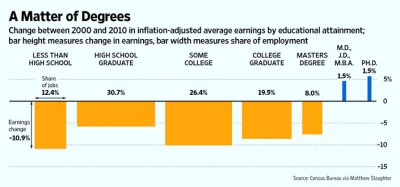September 21, 2011
I remember well the gas shortages of the 1970s. Long lines at the pumps, and gas prices through the roof. Higher prices are, of course, the textbook free-market response to a shortage.
Some economic analysts argue that an important reason we have high unemployment today is because we have a shortage of skilled workers. Employers have good jobs to fill, but they can’t find qualified workers to fill them.
If there really is a shortage of skilled workers, though, we’d expect to see skilled workers’ wages rising. Back in the late 1990s, for example, when the economy experienced four years of sustained low unemployment, and employers really were beating the bushes to fill vacancies, inflation-adjusted wages for workers at all skill levels rose faster than they have during any period in the last three decades.
Journalist David Wessel has posted a magnificent graph at the Real Time Economics blog that shows almost the exact opposite of what we’d expect if there were a shortage of skilled workers.

Source: Matthew Slaughter via David Wessel.
The graph displays the inflation-adjusted change between 2000 and 2010 in the average wage of workers with different education levels. Workers with less than a high school degree saw their real wages fall about 10 percent over the period. Workers with only a high school degree experienced about a 5 percent fall. But, workers with some college (including those with associates degrees) or a bachelors degree or even a masters degree suffered average real wage declines even steeper than those of high school graduates.
The only two groups that experienced real wage increases over the period were workers with MDs, JDs, MBAs, and PhDs. And even these wage increases were small –about one-half of one percent per year.
One particularly nice feature of the graph is that it shows not just the change in wages for each group (on the y-axis), but also the relative size of each education group (on the x-axis). Together, the MDs, JDs, and MBAs make up only 1.5 percent of the workforce; the PhDs, another 1.5 percent.
So, if we have a shortage of skilled workers, it is a peculiar one. Only about 3 percent of workers are in skill groups experiencing average increases in real wages, and those increases border on the impeceptible on an annualized basis.






